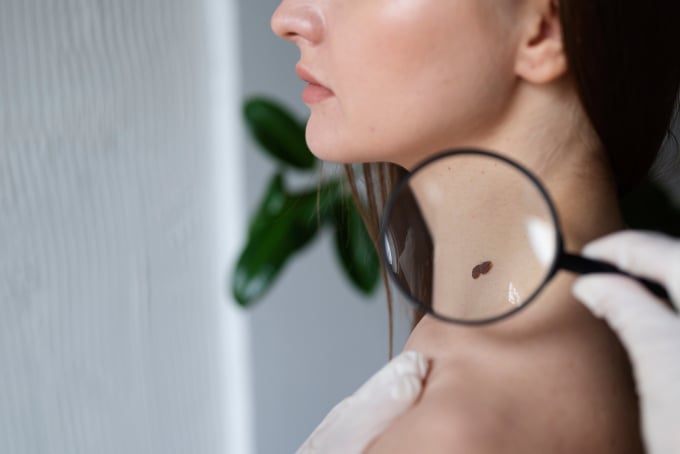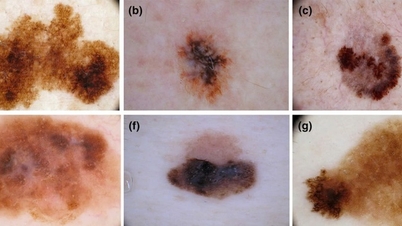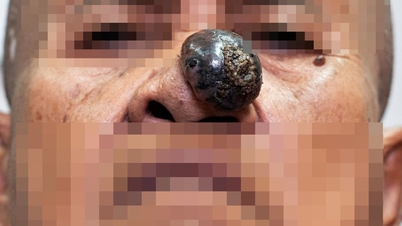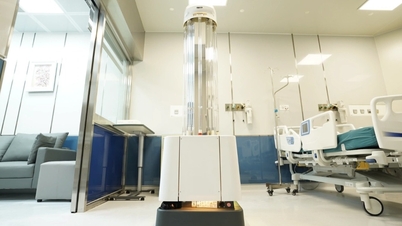Skin lesions with unusual shapes or colors, pimples, rough red spots, or those that are itchy or painful may be signs of malignancy and require attention.
Dr. Vo Thi Tuong Duy, a specialist in Dermatology and Cosmetic Dermatology at Tam Anh General Hospital in Ho Chi Minh City, said that skin cancer is a condition where skin cells grow abnormally and uncontrollably. There are two types of skin cancer: non-melanoma and melanoma. Depending on the type of cancer, the disease will have different recognizable signs. The disease can be identified through specific signs such as:
New skin lesions that vary in size, shape, and color.
The patient experiences itching or pain.
The sores don't heal, they bleed, and they scab over.
A shiny, red bump appears on the skin's surface.
The skin develops bumps that resemble warts.
The red spots are rough and scaly.
The tumor has a raised border and may even bleed.
The skin shows a scar-like mark with no clear outline.
Moles vary in size and have blood vessels surrounding them.

People with skin cancer often have dark moles that change in size rapidly. (Image: Freepik)
The primary cause of skin cancer is radiation from ultraviolet rays in sunlight. However, infrequent sun exposure does not mean you won't get skin cancer. Factors such as genetics, frequent sunbathing, a history of severe sunburns or skin burns, extensive exposure to arsenic or radiation, and overuse of cosmetics containing harmful substances can also contribute to the disease.
Dr. Duy stated that the most common method for diagnosing skin cancer is a general health check-up, taking a personal and family medical history. Afterward, the doctor will assess the lesions by examining the skin, performing a biopsy, and evaluating the histopathology. Depending on the stage of the disease, the patient's health condition, and the histopathological classification of the lesion, the doctor will prescribe surgical removal of the cancerous area (excision, Mohs method, curettage, and electrocautery); chemotherapy; laser light therapy combined with medication; radiation therapy, etc.
To reduce the risk of skin cancer, the best way is to avoid frequent exposure of the skin to sunlight and other sources of UV radiation. Therefore, limit sunbathing and outdoor activities between 10 am and 4 pm; use sunscreen with an SPF of 30 or higher; apply sunscreen at least 30 minutes before going outside and reapply every two hours; wear sun-protective clothing (specifically UV-protective), a wide-brimmed hat, and sunglasses; wear dark-colored clothing instead of light-colored clothing when going outside, as light colors absorb more ultraviolet rays. Regular health checkups are recommended, at least once or twice a year for those at high risk.
Dr. Vo Thi Tuong Duy noted that skin cancer needs to be detected, diagnosed, and treated early to prevent malignant transformation or metastasis leading to death. In the early stages, doctors can treat the cancer without scarring and completely remove the tumor. Patients have a 5-year survival rate of up to 90%. The prognosis is poorer if the cancer is detected and treated at the metastatic stage.
Therefore, if you notice any unusual lesions that persist for several weeks and do not disappear; moles that grow larger and have visible blood vessels around them, you should see a dermatologist or cosmetic skin specialist for early diagnosis and intervention.
Dung Le
Source link



![[Photo] Prime Minister Pham Minh Chinh receives the Governor of Tochigi Province (Japan)](/_next/image?url=https%3A%2F%2Fvphoto.vietnam.vn%2Fthumb%2F1200x675%2Fvietnam%2Fresource%2FIMAGE%2F2025%2F12%2F16%2F1765892133176_dsc-8082-6425-jpg.webp&w=3840&q=75)
![[Image] The tenacious fighting spirit of Vietnamese women's football](/_next/image?url=https%3A%2F%2Fvphoto.vietnam.vn%2Fthumb%2F1200x675%2Fvietnam%2Fresource%2FIMAGE%2F2025%2F12%2F17%2F1765990260956_ndo_br_4224760955870434771-copy-jpg.webp&w=3840&q=75)
![[Live] 2025 Community Action Awards Gala](/_next/image?url=https%3A%2F%2Fvphoto.vietnam.vn%2Fthumb%2F1200x675%2Fvietnam%2Fresource%2FIMAGE%2F2025%2F12%2F16%2F1765899631650_ndo_tr_z7334013144784-9f9fe10a6d63584c85aff40f2957c250-jpg.webp&w=3840&q=75)









































































![[Live] Closing Ceremony and Award Presentation for the "Impressive Vietnam Tourism" Video/Clip Creation Contest 2025](https://vphoto.vietnam.vn/thumb/402x226/vietnam/resource/IMAGE/2025/12/17/1765974650260_z7273498850699-00d2fd6b0972cb39494cfa2559bf85ac-1765959338756946072104-627-0-1338-1138-crop-1765959347256801551121.jpeg)




























Comment (0)